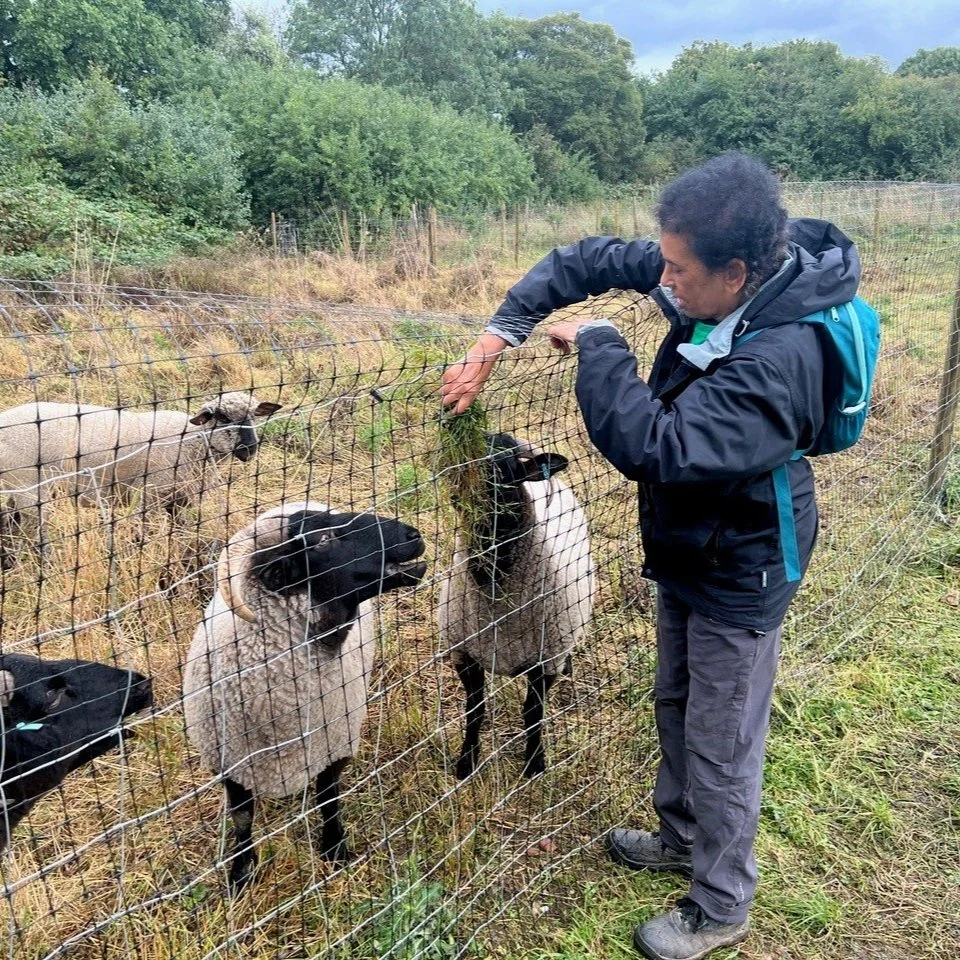Sheep on the Heath
On 11th September 2023, five rare-breed Norfolk Horn and Oxford Down ewes arrived at the Hampstead Heath Extension from Mudchute City Farm and became instant celebrities, attracting attention from members of the public, curious dogs and the media. But they were there not for the cameras but for a serious conservation grazing mission. Find out more below.
Sheep at the Hampstead Heath extension
Conservation grazing
Conservation grazing is a conservation technique making use of grazers (sheep, in this instance!) to maintain and improve wildlife habitats rich in biodiversity, particularly focusing on grasslands. Without grazing (or cutting) grassland habitats progressively turn into scrub and eventually secondary woodland, resulting in habitat loss.
As part of work to maintain a mosaic of habitats on Hampstead Heath, grassland areas are cut seasonally, either mechanically (by being mown) or manually by being scythed (a frequent Heath Hands volunteer task!). Manual cutting is particularly suitable to sites that are less accessible for machinery or more sensitive due to the habitat.
Even more sensitive than volunteers and scythes are grazers and, after an initial pilot in 2019, we were glad to take part in a second conservation grazing project on the Heath this Autumn in partnership with the City of London, the Rare Breeds Survival Trust and the Heath and Hampstead Society.
As well as involving key leads from each organisation, the project was a real community effort, with over 60 volunteers helping out as ‘shepherds’ to ensure the sheep were watched every day from 8am to 7.30pm, to answer any questions from the public and to encourage dog walkers to keep any overenthusiastic dogs on the lead. Many thanks to all involved!
Volunteer leading sheep back to stable
Volunteer and sheep (c. C. Blakemore)
Grazing on the Heath
All conservation and biodiversity work on Hampstead Heath is overseen by the Heath’s Ecologist and Conservation Team and they are keen to explore the benefits of conservation grazing as a technique on the Heath. Indeed, there were grazers on the Heath up to the mid-1950s, creating a more open landscape and ideal conditions for many invertebrate species. Since this time, the Heath has become a much more wooded environment, which has been beneficial to some species of flora and fauna, but detrimental to others. A return to the open landscape of the early 1900s isn’t envisaged, but grazing animals may play a part in managing more sensitive habitats, bringing ecological improvements to a selection of sites.
Sheep grazing on Hampstead Heath in 1922
Grazers can produce a mosaic of vegetation heights and types, improving habitats and increasing micro-habitats. They can also reduce competition for sensitive plant species through poaching (trampling) of the ground and reducing scrub species, preventing coarser grasses and scrub from taking over. This can improve conditions for certain invertebrates.
The Heath Extension site and meadow ants
The site chosen for this project was an area of grassland on the Hampstead Heath extension, which is home to meadow ants. The anthills are valuable for biodiversity as they result in a greater diversity of flora and fauna and the habitat is particularly important to one of our species of birds, the green woodpecker. Conversely, they create a particularly unsuitable site for machinery as the anthills make the ground uneven and the machinery risks damaging the ants.
Sheep with grazed anthills in background (photo C. Blakemore)
The first aim of the conservation grazing project on the Heath was to assess the ecological impact of the grazing - this is being measured with help from the London Natural History Society, which carried out an ecological survey on site before the grazing week and will return after they have left.
A second aim was to work through the practicalities of grazing on the Heath, assessing public reaction to the sheep’s presence and ensuring the animals’ safety - both in terms of public attention, and in terms of the presence of dogs, for instance.
Analysis of the impact is still ongoing, but initial indications are that the sheep have had a beneficial impact on the site, revealing the anthills, for example. Plans are already being made to bring the sheep back again next year, so watch this space!





